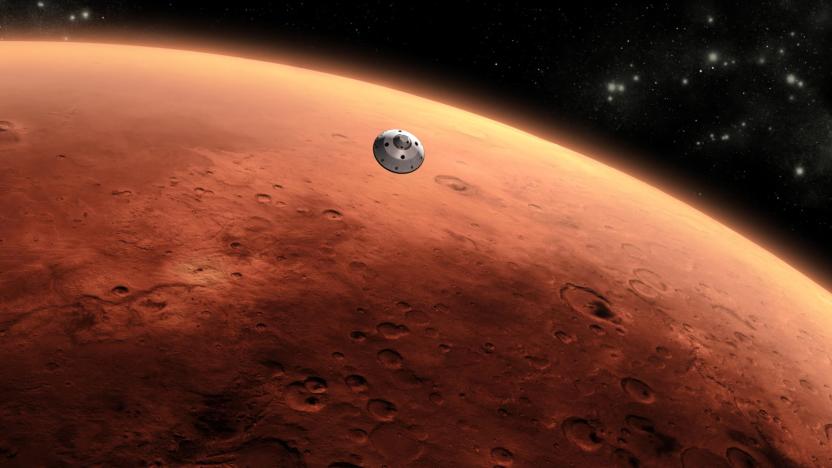MarsExpress
Latest

Mars Express orbiter snaps stunning image of Korolev crater
The European Space Agency has released a gorgeous composite image of Mars' Korolev crater, an 82-kilometer-wide crater situated in the planet's northern lowlands. The ESA's Mars Express orbiter snapped pictures of the crater over the course of five orbits, and five "strips" were combined to make this stunning image. The Korolev crater is filled with 1.8-kilometer-thick ice year round, which is believed to be maintained by an occurrence known as a "cold trap." The air moving across the crater's ice cools down, sinks and then acts as a sort of shield over the ice, keeping it cold and frozen all year long.

Scientists may have found liquid water on Mars
Today, scientists announced that they have detected what could be a large reservoir of liquid water under the surface of Mars. The "lake" measures 20-km across and is located about 1.5 km below Mars's southern polar ice cap. An article about the discovery was published in the journal Science.

Mars' liquid water may have had an atmospheric 'escape route'
Scientists have long believed that Mars lost its liquid water very gradually, turning into a mostly dry planet over an extremely long time frame. However, they may have to toss that assumption out the window. A University of Colorado, Boulder team has discovered that Mars has an atmospheric "escape route" which may have helped hydrogen drift into space at much faster rates. Mars Express data shows that water molecules float higher than usual during the planet's warmer seasons, avoiding an Earth-like "cold trap" that keeps water close to the ground. Once the molecules are in the middle atmosphere, ultraviolet light helps break them up into oxygen and hydrogen -- and since hydrogen is very light, it doesn't take much for the element to escape Mars' gravity.

Mars Express videos the red planet from orbit
Here's something for those tired of looking at rock-and-dust photos of Mars: an entrancing video clip of the planet spinning taken by the European Space Agency's Mars Express. ESA's Mars Express mission is comprised of a lander called Beagle 2 and an orbiter, which was responsible for the video embedded below the fold. The orbiter used its Visual Monitoring Camera on May 25th and 26th, 2015 to record from an orbit close enough to make some of the planet's surface features visible. While it's great that we now know what Mars looks like from up close, we appreciate a dreamy full-orbital movie like this, as well.

Visualized: On Mars, rivers are deep, mountains remain high
Mars Express' mooch around the red planet has yielded another set of snaps it felt worthy of adding to its Facebook wall. It's spent some time looking at the Reull Valliss, a dry river that runs for the better part of 932 miles (1,500km) through the Promethei Terra highlands -- and in some places is over 4.3 miles (7km) wide and nearly 1,000 feet (300m deep). Scientists think that at some point, there was plenty of water in the area, as the landscape shows signs of glaciation. Fancy a short game of amateur topographer? Check out the gallery we've got for you. [Image Credit: ESA/DLR/FU, G. Neukum]

Mars Express captures Phobos in orbit, has bad video to prove it
Alright stargazers, listen up! You know that video you just watched above? Yeah, well that's not terrible 1995-era CGI, it's actually mind-blowing footage of the Martian moon, Phobos, passing by Jupiter in the distance. Credit goes to the insanely brainy folks over at the European Space Agency who captured 104 images of this special alignment on June 1st over a measly 68 seconds using their Mars Express probe. True, it does take a little bit of imagination to get the full sense of just how awe-inspiring this is, but consider this -- the distance between Mars Express and Jupiter at the time of alignment comes in at 529 million kilometers. That's about 329 million miles for those of you still not sufficiently impressed. Try doing that with your high-end DSLR.





